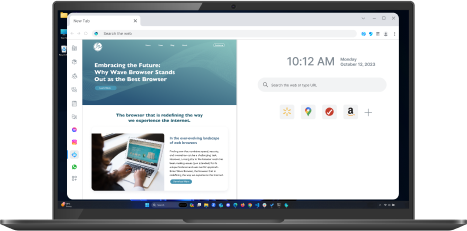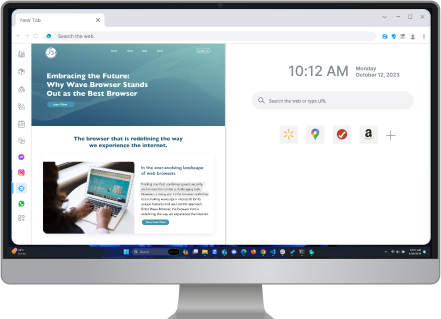Learn How to Interpret Your Browser Speedometer Score
Table of Contents

In the modern web, browser performance plays a important role in user satisfaction. A slow website can frustrate users, causing them to leave quickly and ultimately impacting your bottom line. For browser developers aiming to deliver a fast and seamless experience, it's essential to have accurate results that reflect how well your browser performs.
This is where browser benchmarks like Speedometer come in. They provide valuable insights into your web app’s responsiveness and highlight areas for improvement. By understanding your Speedometer score, you can make informed decisions to enhance browser performance and ensure a smoother user experience.
What is Speedometer?
Speedometer is a browser benchmark tool designed to measure the responsiveness and performance of web applications. It simulates user interactions, such as adding to-do list items or navigating through a web app, to evaluate how efficiently a browser processes JavaScript-heavy tasks and handles DOM updates.
Developed by the WebKit team, the latest release of Speedometer continues to refine testing accuracy across major browser engines, including Chromium, WebKit, and Gecko. By analyzing rendering, scripting, and layout performance, Speedometer helps browser developers and web performance enthusiasts assess how well a browser handles modern web applications.
Understanding Browser Speedometer Scores
Imagine you're checking how fast a car is. You wouldn’t only look at its top speed; you’d also look at how quickly it speeds up, how well it handles, and other things. In the same way, a browser benchmark like Speedometer checks how quickly web applications respond. It does this by mimicking user actions, like adding to-do items. This gives a full view of performance.
Remember, though, that Speedometer is just one tool for checking web browser performance. It gives good insights, but it should not be the only way to judge a browser's speed. Other important things, like internet connection and the device you use, also matter.
A higher Speedometer score indicates improved web app responsiveness and faster performance.
The Basics of Browser Performance Testing
Web browser performance testing checks how quickly and efficiently a browser opens and shows web pages. Speedometer is a key tool in this area, as it uses a specialized test harness to measure these features.
The Browser Speedometer test mimics user interactions in demo web apps to see how responsive they are. It uses various modern JavaScript frameworks and libraries, creating a test environment that feels like real-world web app usage.
This allows for a more accurate assessment of a browser's ability to handle the demands of today's complex web applications, including popular browsers like Safari, Mozilla Firefox, Google Chrome, and Microsoft Edge.
Key Factors Influencing Your Speedometer Score
There are several things that can affect your Browser Speedometer score. These include:
- Efficiency of DOM APIs: How fast a browser can work with the Document Object Model (DOM) is very important. Good handling of user actions like clicking, scrolling, and typing can lead to a higher score.
- JavaScript Execution Time: How quickly JavaScript runs and how well tasks are handled affects how smoothly user actions are done. This change has a direct impact on the benchmark score.
- Underlying Browser Engine: The main browser engine is key. It is in charge of reading HTML, CSS, and JavaScript. Different browser engines optimize these processes in different ways, which can change the overall performance score.
Enhancing Browser Performance Based on Speedometer Results

Once you understand your Browser Speedometer score, you can start improving its performance.
It’s important to know what affects your score and tackle those issues directly. This could mean improving your web page's code, using browser caching, or adjusting your server settings. A mix of these methods usually gives the best results.
Optimizing Page Load Times
Page load times are very important for a good user experience. To make yours better, think about these tips:
- Streamlining CSS and JavaScript: Make your CSS and JavaScript files smaller and combine them. This cuts down on the number of requests the browser needs to make, making your page load faster.
- Leveraging Asynchronous Loading: Load less important things like images and videos at the same time. This stops them from slowing down the main content from showing up.
- Optimizing HTTP Requests: Reduce the number of HTTP requests by merging files, using CSS sprites, and using browser caching well.
Reducing JavaScript Execution Time
JavaScript execution speed has a big impact on how responsive a browser is. To improve this:
- Optimize JavaScript Code: Keep your JavaScript code clean and efficient. Remove any unnecessary tasks. Regularly check your code to find slow parts.
- Use Efficient APIs and Data Structures: Pick the best APIs for your needs. Use efficient data structures to improve how you handle and process data.
- Minimize DOM Access: Each time you interact with the DOM, it can slow things down. Try to cut back on unnecessary DOM changes and use methods like document fragmentation to reduce this slow down.
Advanced Tips for Power Users
For those looking to maximize browser performance, here are some advanced tips that focus on leveraging browser-specific features and fine-tuning settings to achieve optimal performance:
Leveraging Browser Caching for Better Speeds
Modern browsers have smart caching tools that can greatly speed up how fast pages load:
- Use Browser Cache: Set up your server to create the right caching headers for static files like images, CSS, and JavaScript.
- Use Service Workers: For web apps, use service workers to cache files and even whole pages. This helps with offline access and makes future loads faster.
- Optimize for Different Use Cases: Think about using different caching methods for various devices and network speeds. This can help make sure everything works well for all users.
Minimizing HTTP Requests
Reducing the number of HTTP requests your web page makes is important for loading faster:
- Combine and Minify Files: Merge your CSS and JavaScript files to lower the number of requests the browser has to make.
- Utilize CSS Sprites: Join several images into one image file and use CSS background positioning to show only the parts you want.
- Adopt Web Components: Think about splitting your user interface into smaller web components. This helps with better caching and reduces data transfers for each request.
To make your website work better, it's important to understand and improve your browser speedometer scores. You can do this by making page load times quicker and reducing how much JavaScript runs. If you are a developer or marketer, this optimizations will help users enjoy their visit and boost your SEO rankings.
A good score shows that your browsing speed is efficient. You can get even better results by using smart methods like browser caching and lowering the number of HTTP requests. Stay updated, be knowledgeable, and see your website's performance improve. Keep aiming for great results in browser performance testing for
Surf with Ease, Speed, and Security!

Download Wave Browser for a seamless online experience like never before. Try it now!


























